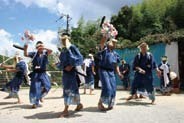

Total:35items
- Folk Performing Art (16)
- Kenbai: Sword Dance
- Kirin Shishimai: Kylin Lion Dance
- Yoshiwa Taiko Odori: Yoshiwa Drum Dance
- Omiya Odori: Omiya Dance
- Tsurusaki-Odori festival
- Omi Take-no-karakai (Tug-of-wars with bamboo)
- Nakizumo: Crying Baby Sumo
- Ryugasaki Tsukumai:Ryugasaki Acrobatic Performance
- Mikawa Manzai
- Esashi Oiwake: Esashi Folk Singing
- Ayado Yonenbutsu and Bon festival dance
- Occhi-no-Ohinagayu (rice porridge offering for the Doll's Festival in Occhi)
- Hanatori-odori Dance (Masuda area)
- Kaga-manzai
- Rice Planting festival of Tsutsukowake Shrine
- Edo sato kagura: Edo folk dance for entertaining god
- Kabuki (2)
- Noh & Kyogen (1)
- Festival (10)
- Ritual & Ceremony (2)
- Puppet Play (2)
- Folk technology (2)

 |
|
《Feature》
Hanatori Dance is one of the performing arts by Shugendo practitioners, danced in a part of Nanyo (Southern Ehime Prefecture) and throughout Tosa (current Kochi Pref., West Japan) which is said to the place of its origin. From the lyrics and performers playing metal drums, we can see that the Nenbutsu (a Buddhist chant) dance was brought into the Hanatori dance. "Hanatori" means fighting over flowers offered before the gods such as Japanese star anise, cleyera japonica, azalea and rhododendron.
'Sayaharai (a conflict between mountain priests)' in the Hanatori Dance in Masuda area symbolizes a conflict between the Honzan group (Tendai School) and Touzan group (Shingon School) . In the dance, performers hit each other with green bamboo logs and we can see the influence by a Shinto ritual of Tosa called "bou-uchi (hitting each other with sticks.) A sword used in the dance represents the one which drives away evil, while an inverted sickle which is usually disliked signifies driving away of evil and disaster averting. The dance takes place in the premise of Anyo-ji Temple on July 11th on lunar calendar after performers go through a 7-day cold water ablution to purify their bodies. The performers wear an indigo-dyed casual linen kimono, tuck up their sleeves with a sash and put a headband which looks like a hood worn by Rokuju-rokubu (pilgrims who make a pilgrimage to 66 hallowed grounds) around their heads.
[Nationally selected intangible folk cultural asset]
Source: Ainan Town Board of Education
Translation by: Marie Mine, reviewed by Tomoko Yamamoto
Hanatori Dance is one of the performing arts by Shugendo practitioners, danced in a part of Nanyo (Southern Ehime Prefecture) and throughout Tosa (current Kochi Pref., West Japan) which is said to the place of its origin. From the lyrics and performers playing metal drums, we can see that the Nenbutsu (a Buddhist chant) dance was brought into the Hanatori dance. "Hanatori" means fighting over flowers offered before the gods such as Japanese star anise, cleyera japonica, azalea and rhododendron.
'Sayaharai (a conflict between mountain priests)' in the Hanatori Dance in Masuda area symbolizes a conflict between the Honzan group (Tendai School) and Touzan group (Shingon School) . In the dance, performers hit each other with green bamboo logs and we can see the influence by a Shinto ritual of Tosa called "bou-uchi (hitting each other with sticks.) A sword used in the dance represents the one which drives away evil, while an inverted sickle which is usually disliked signifies driving away of evil and disaster averting. The dance takes place in the premise of Anyo-ji Temple on July 11th on lunar calendar after performers go through a 7-day cold water ablution to purify their bodies. The performers wear an indigo-dyed casual linen kimono, tuck up their sleeves with a sash and put a headband which looks like a hood worn by Rokuju-rokubu (pilgrims who make a pilgrimage to 66 hallowed grounds) around their heads.
[Nationally selected intangible folk cultural asset]
Source: Ainan Town Board of Education
Translation by: Marie Mine, reviewed by Tomoko Yamamoto
| City/Town | 2648 Masuda, Ainan-Cho, Minamiuwa-Gun, Ehime Prefecture |
|---|---|
| Location | Ainan-Cho, Minamiuwa-Gun, Ehime |
| Contact | Lifelong Learning Division, Ainan Town Board of Education
Tel: +81-(0)895-73-1111 (Japanese only) Assistance needed? For inquiries in English: JTCO Contact Form Your inquiries will be forwarded by JTCO in Japanese to the organization you wish to contact. |



